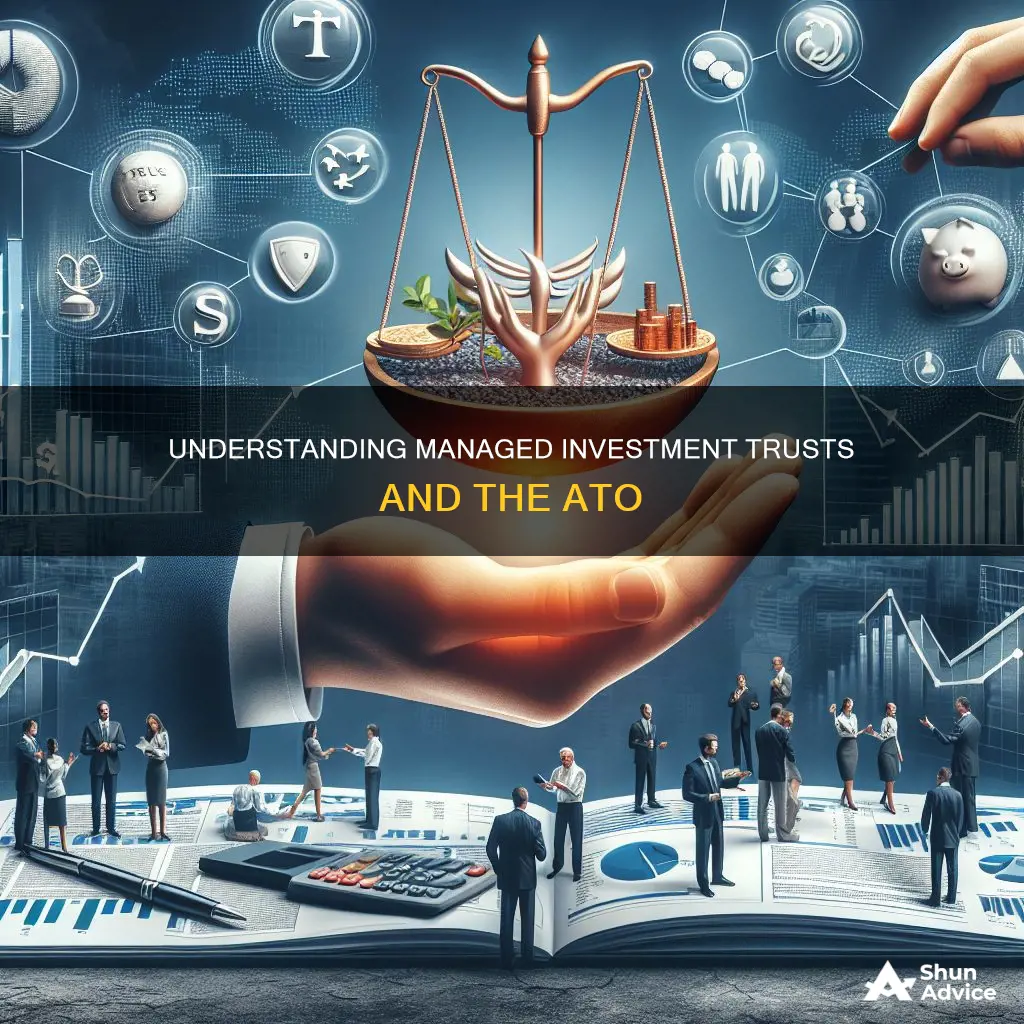
A managed investment trust (MIT) is a type of trust in which members of the public collectively invest in passive income activities, such as shares, property, or fixed-interest assets. MITs are generally taxed under the trust provisions in Division 6 of the Income Tax Assessment Act 1936 (ITAA 1936), which taxes beneficiaries based on their share of the net income of a trust. On May 5, 2016, the Australian government enacted changes to the taxation of MITs, allowing eligible MITs to elect into a new attribution regime and be referred to as attribution managed investment trusts (AMITs). AMITs are generally taxed under Division 276 of the Income Tax Assessment Act 1997 (ITAA 1997) and benefit from a new tax system that introduces changes to withholding and non-arm's length income rules.
| Characteristics | Values |
|---|---|
| Type of trust | A managed investment trust (MIT) is a type of trust in which members of the public collectively invest in passive income activities, such as shares, property or fixed-interest assets. |
| Taxation | MITs (and their members) are generally taxed under the trust provisions in Division 6 of the Income Tax Assessment Act 1936 (ITAA 1936). |
| Beneficiaries | Beneficiaries are generally taxed on their share of the net income of a trust or the trustee is taxed on their behalf, based on the 'present entitlement' of beneficiaries to trust income. |
| Eligibility requirements | To qualify as a MIT, the trust must meet certain requirements for the income year it is in operation. These include: the trustee being an Australian resident; the trust not carrying on or controlling an active trading business; being a managed investment scheme; meeting the widely held and closely held requirements; and being operated or managed by an appropriately regulated entity. |
| Changes to taxation | On 5 May 2016, the government enacted changes to the taxation of MITs. Eligible MITs may elect to apply new rules, which include the use of an attribution method of tax and the ability to carry forward under- and over-estimates of tax amounts. |
| Types of managed investment trusts | Cash management trusts, managed funds (e.g. property trust, share trust, equity trust), growth trust, imputation trust, balanced trust. |
| Trust income and credits | Any income or credits received from trust investment products must be shown in the tax return. This includes income and capital gains from a trust, capital gains or losses when disposing of MIT units, and any share of a national rental affordability scheme tax offset. |
| Trust income deductions | Tax deductions for MITs can include interest on money borrowed to invest. Prepayments of $1,000 or more in relation to the managed investment may affect the amount that can be deducted. |
| Capital gains from a trust | Distributions from trusts can include non-assessable payments, which may affect the cost base of units in a unit trust and create a capital gain. |
What You'll Learn

Types of managed investment trusts
A managed investment trust (MIT) is a type of trust where members collectively invest in passive income activities, such as shares, property or fixed-interest assets.
To qualify as an MIT, certain requirements must be met. These include the trustee being an Australian resident or the central management and control of the trust being in Australia, the trust not carrying on or controlling an active trading business, and the trust being a managed investment scheme, widely held, and operated or managed by an entity with an Australian Financial Services Licence or a Crown entity.
There are various types of managed investment trusts, including:
- Cash management trusts
- Managed funds, such as property trusts, share trusts, equity trusts, growth trusts, imputation trusts, and balanced trusts
- Australian equity (share) schemes
- International equity schemes
- Exchange-traded funds (ETFs)
- Agricultural schemes (e.g. horticulture, aquaculture, viticulture)
- Horse-breeding and horse-racing schemes
- Time-sharing schemes
- Serviced strata schemes
It is important to note that only certain trust types can qualify as managed investment trusts. Discretionary trusts, family trusts, and deceased estates do not qualify as MITs, even if they hold passive investments.
Managing Calpers Investments: Strategies for Success
You may want to see also

Trust income and credits
Any income or credits received from trust investment products must be declared on your tax return. This includes income and capital gains from a trust, such as a managed fund, as well as any capital gains or losses when you dispose of your managed investment trust units. Your distribution advice or statement from the trust will provide the necessary information to complete your tax return.
If you receive income from a trust, you may be required to report a loss on your tax return in certain circumstances. This occurs if you are eligible to use averaging provisions available to primary producers and the trust has made a loss from its primary production activities but still has an overall net income amount, which it distributes to you. Your distribution advice or statement will separately identify your share of any primary production loss and your share of other income.
You can claim tax credits for tax paid on or withheld from trust income, including fund payments from a managed investment trust, as well as withholding tax for foreign residents and non-residents.
Trust Income Deductions
Tax deductions for managed investment trusts can include interest on money borrowed to invest. However, there are special rules for prepayments of $1,000 or more that may impact the deductible amount. Additionally, you cannot claim deductions for expenses incurred in deriving exempt income or non-assessable non-exempt income, such as expenses with family trust distribution tax or trustee beneficiary non-disclosure tax already paid. Deductions are also not allowed for amounts already claimed by the trust, such as expenditures on landcare operations or water facilities.
Strategizing Dividend Investment: Balancing Your Portfolio
You may want to see also

Trust income deductions
Managed investment trusts (MITs) are a type of trust in which members of the public collectively invest in passive income activities, such as shares, property, or fixed-interest assets. MITs are taxed under the trust provisions in Division 6 of the Income Tax Assessment Act 1936. Under these provisions, beneficiaries are generally taxed on their share of the net income of a trust, or the trustee is taxed on their behalf, based on the beneficiaries' 'present entitlement' to trust income.
When it comes to trust income deductions for MITs, there are several important considerations:
- Tax deductions for managed investment trusts can include interest on money borrowed to invest. This includes interest charged on money borrowed to purchase shares and other related investments that generate assessable interest or dividend income.
- Management fees, specialist journals, and ongoing management fees or retainers are also deductible.
- If you made a prepayment of $1,000 or more in relation to your managed investment, there are special rules that may affect the amount you can deduct.
- You cannot claim a deduction for expenses incurred in deriving exempt income or non-assessable non-exempt income, such as expenses incurred in deriving distributions on which family trust distribution tax has been paid.
- You also cannot claim a deduction for amounts the trust has already claimed or that only the trust can claim, such as expenditure on landcare operations or water facilities.
- Only interest expenses incurred for an income-producing purpose are deductible. If the borrowed money was used for both private and income-producing purposes, the Australian Taxation Office (ATO) expects that any interest will be apportioned between each purpose.
- You can claim a deduction for your share of fees, charges, or taxes on a joint account. For example, if you hold an equal share in an account with your spouse, you can claim half of any allowable account-keeping fees paid.
- If you attend an investment seminar, there may be scope for claiming related travel and other expenses, but this is assessed on a case-by-case basis.
ETFs: Managed Investments or Not?
You may want to see also

Capital gains from a trust
A managed investment trust (MIT) is a type of trust where members of the public collectively invest in passive income activities, such as shares, property, or fixed-interest assets. The capital gains of a trust are calculated by determining the net capital gain or loss for an income year. This is done by assessing the disposal of trust assets or other capital gains tax events, which may result in a capital gain or loss for the trust.
The trustee of a resident trust can choose to be taxed on a capital gain if no beneficiary has received or benefited from the gain during the income year or within two months of the end of the year. This allows the trustee to pay tax on behalf of a beneficiary who doesn't immediately benefit from the gain. If a beneficiary is absolutely entitled to a trust asset, it is treated as if owned directly by the beneficiary and any capital gains or losses are made directly by them, not forming part of the trust's net income.
When a beneficiary is specifically entitled to a capital gain, this is taken into account when calculating their net capital gain for the income year, with the benefit of any applicable discounts or concessions. This is relevant for capital gains tax (CGT) purposes. Non-assessable payments from a trust, such as profits from the sale of property acquired before 20 September 1985, do not create assessable income for beneficiaries in most cases. However, these payments may require adjustments to the cost base of units or trust interests, impacting any capital gains or losses.
For beneficiaries of trusts, it is essential to determine your share of each capital gain made by the trust that has been included in its net income for tax purposes. This information should be provided in the statement of distribution or advice from the trust, along with details such as the type of capital gain, calculation method, and any applicable discounts or concessions. These details are crucial for accurately calculating and reporting capital gains from a trust on your tax return.
Ethical Investment Portfolios: Doing Well by Doing Good
You may want to see also

Attribution managed investment trusts
On 5 May 2016, the Australian government enacted changes to the taxation of managed investment trusts (MITs). Eligible MITs may now elect to apply a new set of rules for an income year starting on or after 1 July 2015. By opting into the new regime, these MITs become attribution managed investment trusts (AMITs) and are generally taxed under Division 276 of the Income Tax Assessment Act 1997 (ITAA 1997).
The new tax system introduces several changes, including:
- AMITs can use an attribution method of tax instead of the existing present entitlement to income method in Division 6 of the ITAA 1936.
- AMITs can carry forward under- and over-estimates of tax amounts into the discovery income year without adverse tax consequences.
- AMITs that meet eligibility requirements are deemed to be fixed trusts.
- Unit holders in AMITs can make both upward and downward adjustments to the cost base of their unit holdings to eliminate double taxation.
- An arm's length rule is introduced for all MITs to ensure related entities undertake transactions that reflect commercial dealings.
- The 20% tracing rule for public unit trusts in Division 6C of the ITAA 1936 is amended so it does not apply to super funds and exempt entities entitled to a refund of excess imputation credits.
To become an AMIT, a trust must meet certain eligibility requirements for the income year in which it operates. These include:
- The trustee is an Australian resident, or the central management and control of the trust is in Australia.
- The trust does not carry on or control an active trading business.
- The trust is a managed investment scheme.
- The trust meets the widely held requirement.
- The trust meets the closely held restriction.
- The trust is operated or managed by an appropriately regulated entity.
Managing Assets: Advising Advisors for Investment Success
You may want to see also
Frequently asked questions
A managed investment trust (MIT) is a publicly-held and commercially-operated collective investment trust that invests in primarily passive income activities such as shares, property or fixed-interest assets.
For the income year in which it operates, a trust qualifies as a MIT if:
- The trustee is an Australian resident or the central management and control of the trust is in Australia.
- The trust does not carry on or control an active trading business.
- The trust is a managed investment scheme.
- The trust meets the widely held requirement.
- The trust meets the closely held restriction.
- The trust is operated or managed by an appropriately regulated entity.
MITs (and their members) are generally taxed under the trust provisions in Division 6 of the Income Tax Assessment Act 1936 (ITAA 1936). Under these provisions, beneficiaries are taxed on their share of the net income of a trust or the trustee is taxed on their behalf, based on the 'present entitlement' of beneficiaries to trust income.
An AMIT is a term used for a MIT that has elected to apply the new tax system for MITs, enacted in May 2016. AMITs are generally taxed under Division 276 of the Income Tax Assessment Act 1997 (ITAA 1997) and can use an attribution method of tax.







